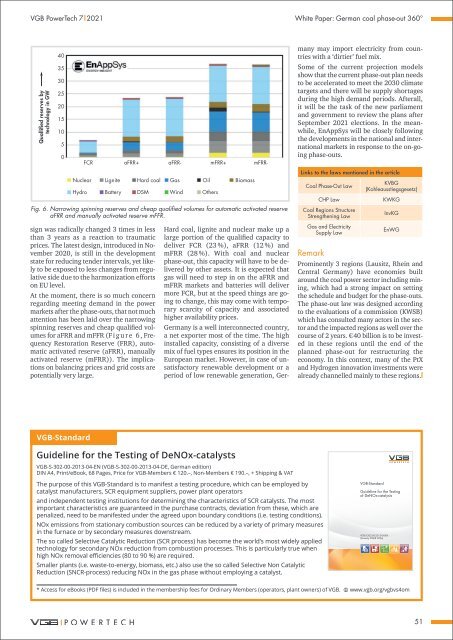VGB POWERTECH 7 (2021) - International Journal for Generation and Storage of Electricity and Heat
VGB PowerTech - International Journal for Generation and Storage of Electricity and Heat. Issue 7 (2021). Technical Journal of the VGB PowerTech Association. Energy is us! Optimisation of power plants. Thermal waste utilisation.
VGB PowerTech - International Journal for Generation and Storage of Electricity and Heat. Issue 7 (2021).
Technical Journal of the VGB PowerTech Association. Energy is us!
Optimisation of power plants. Thermal waste utilisation.
- No tags were found...
You also want an ePaper? Increase the reach of your titles
YUMPU automatically turns print PDFs into web optimized ePapers that Google loves.
<strong>VGB</strong> PowerTech 7 l <strong>2021</strong> White Paper: German coal phase-out 360°<br />
Quallified reserves by<br />
technology in GW<br />
40<br />
35<br />
30<br />
25<br />
20<br />
15<br />
10<br />
5<br />
0<br />
FCR aFRR+ aFRR- mFRR+ mFRR-<br />
Nuclear Lignite Hard coal Gas Oil Biomass<br />
Hydro Battery DSM Wind Others<br />
Fig. 6. Narrowing spinning reserves <strong>and</strong> cheap qualified volumes <strong>for</strong> automatic activated reserve<br />
aFRR <strong>and</strong> manually activated reserve mFFR.<br />
sign was radically changed 3 times in less<br />
than 3 years as a reaction to traumatic<br />
prices. The latest design, introduced in November<br />
2020, is still in the development<br />
state <strong>for</strong> reducing tender intervals, yet likely<br />
to be exposed to less changes from regulative<br />
side due to the harmonization ef<strong>for</strong>ts<br />
on EU level.<br />
At the moment, there is so much concern<br />
regarding meeting dem<strong>and</strong> in the power<br />
markets after the phase-outs, that not much<br />
attention has been laid over the narrowing<br />
spinning reserves <strong>and</strong> cheap qualified volumes<br />
<strong>for</strong> aFRR <strong>and</strong> mFFR (F i g u r e 6 , Frequency<br />
Restoration Reserve (FRR), automatic<br />
activated reserve (aFRR), manually<br />
activated reserve (mFRR)). The implications<br />
on balancing prices <strong>and</strong> grid costs are<br />
potentially very large.<br />
Hard coal, lignite <strong>and</strong> nuclear make up a<br />
large portion <strong>of</strong> the qualified capacity to<br />
deliver FCR (23 %), aFRR (12 %) <strong>and</strong><br />
mFRR (28 %). With coal <strong>and</strong> nuclear<br />
phase-out, this capacity will have to be delivered<br />
by other assets. It is expected that<br />
gas will need to step in on the aFRR <strong>and</strong><br />
mFRR markets <strong>and</strong> batteries will deliver<br />
more FCR, but at the speed things are going<br />
to change, this may come with temporary<br />
scarcity <strong>of</strong> capacity <strong>and</strong> associated<br />
higher availability prices.<br />
Germany is a well interconnected country,<br />
a net exporter most <strong>of</strong> the time. The high<br />
installed capacity, consisting <strong>of</strong> a diverse<br />
mix <strong>of</strong> fuel types ensures its position in the<br />
European market. However, in case <strong>of</strong> unsatisfactory<br />
renewable development or a<br />
period <strong>of</strong> low renewable generation, Germany<br />
may import electricity from countries<br />
with a ‘dirtier’ fuel mix.<br />
Some <strong>of</strong> the current projection models<br />
show that the current phase-out plan needs<br />
to be accelerated to meet the 2030 climate<br />
targets <strong>and</strong> there will be supply shortages<br />
during the high dem<strong>and</strong> periods. Afterall,<br />
it will be the task <strong>of</strong> the new parliament<br />
<strong>and</strong> government to review the plans after<br />
September <strong>2021</strong> elections. In the meanwhile,<br />
EnAppSys will be closely following<br />
the developments in the national <strong>and</strong> international<br />
markets in response to the on-going<br />
phase-outs.<br />
Links to the laws mentioned in the article<br />
Coal Phase-Out Law<br />
CHP Law<br />
Coal Regions Structure<br />
Strengthening Law<br />
Gas <strong>and</strong> <strong>Electricity</strong><br />
Supply Law<br />
KVBG<br />
(Kohleausstiegsgesetz)<br />
KWKG<br />
InvKG<br />
EnWG<br />
Remark<br />
Prominently 3 regions (Lausitz, Rhein <strong>and</strong><br />
Central Germany) have economies built<br />
around the coal power sector including mining,<br />
which had a strong impact on setting<br />
the schedule <strong>and</strong> budget <strong>for</strong> the phase-outs.<br />
The phase-out law was designed according<br />
to the evaluations <strong>of</strong> a commission (KWSB)<br />
which has consulted many actors in the sector<br />
<strong>and</strong> the impacted regions as well over the<br />
course <strong>of</strong> 2 years. € 40 billion is to be invested<br />
in these regions until the end <strong>of</strong> the<br />
planned phase-out <strong>for</strong> restructuring the<br />
economy. In this context, many <strong>of</strong> the PtX<br />
<strong>and</strong> Hydrogen innovation investments were<br />
already channelled mainly to these regions.l<br />
<strong>VGB</strong>-St<strong>and</strong>ard<br />
Guideline <strong>for</strong> the Testing <strong>of</strong> DeNOx-catalysts<br />
<strong>VGB</strong>-S-302-00-2013-04-EN (<strong>VGB</strong>-S-302-00-2013-04-DE, German edition)<br />
DIN A4, Print/eBook, 68 Pages, Price <strong>for</strong> <strong>VGB</strong>-Members € 120.–, Non-Members € 190.–, + Shipping & VAT<br />
The purpose <strong>of</strong> this <strong>VGB</strong>-St<strong>and</strong>ard is to manifest a testing procedure, which can be employed by<br />
catalyst manufacturers, SCR equipment suppliers, power plant operators<br />
<strong>and</strong> independent testing institutions <strong>for</strong> determining the characteristics <strong>of</strong> SCR catalysts. The most<br />
important characteristics are guaranteed in the purchase contracts, deviation from these, which are<br />
penalized, need to be manifested under the agreed upon boundary conditions (i.e. testing conditions).<br />
NOx emissions from stationary combustion sources can be reduced by a variety <strong>of</strong> primary measures<br />
in the furnace or by secondary measures downstream.<br />
The so called Selective Catalytic Reduction (SCR process) has become the world’s most widely applied<br />
technology <strong>for</strong> secondary NOx reduction from combustion processes. This is particularly true when<br />
high NOx removal efficiencies (80 to 90 %) are required.<br />
Smaller plants (i.e. waste-to-energy, biomass, etc.) also use the so called Selective Non Catalytic<br />
Reduction (SNCR-process) reducing NOx in the gas phase without employing a catalyst.<br />
<strong>VGB</strong>-St<strong>and</strong>ard<br />
Guideline <strong>for</strong> the Testing<br />
<strong>of</strong> DeNOx-catalysts<br />
<strong>VGB</strong>-S-302-00-2013-04-EN<br />
(<strong>for</strong>merly <strong>VGB</strong>-R 302e)<br />
* Access <strong>for</strong> eBooks (PDF files) is included in the membership fees <strong>for</strong> Ordinary Members (operators, plant owners) <strong>of</strong> <strong>VGB</strong>. www.vgb.org/vgbvs4om<br />
51


















